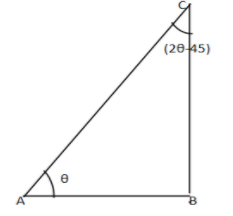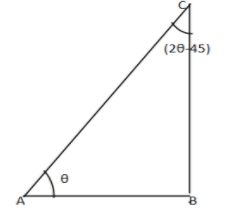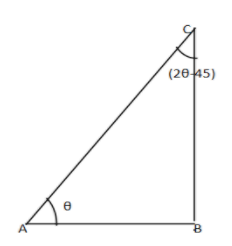Answer
405k+ views
Hint:
We know that $\theta {\text{ and (2}}\theta - 45)$ are acute angles so we can say that $\theta < 90$ and also that ${\text{(2}}\theta - 45) < 90$ and also we know that $\sin \theta = \cos (2\theta - 45)$ and we know that $\cos ( - \theta ) = \cos (\theta )$
Complete step by step solution:
Here in the question we are given that $\theta {\text{ and (2}}\theta - 45)$ are the acute angles and it satisfies that$\sin \theta = \cos (2\theta - 45)$

Now we know that $\cos ( - \theta ) = \cos (\theta )$
So we can say that $\cos (2\theta - 45) = \cos (45 - 2\theta )$
Now adding and subtracting $45$ from both the sides we get that
$
\Rightarrow \cos (2\theta - 45 + 45 - 45) = \cos (45 - 2\theta + 45 - 45) \\
\Rightarrow \cos (2\theta - 45 + 45 - 45) = \cos (90 - 2\theta - 45) \\
$
Also we know that $\cos (2\theta - 45) = \sin (\theta )$
So we can write that
$\sin \theta = \sin (2\theta + 45)$
We know the formula that if $\sin \alpha = \sin \beta $ then its general equation can be formed by
$\alpha = n\pi + {( - 1)^n}\beta $
So here $\alpha = 2\theta + 45,\beta = \theta $
So we get that the general equation of the $\sin \theta = \sin (2\theta + 45)$ is
$2\theta + 45 = n\pi + {( - 1)^n}\theta $
So we can write $45^\circ $ as $\dfrac{\pi }{4}$ in radians then we will get that
$2\theta + \dfrac{\pi }{4} = n\pi + {( - 1)^n}\theta - - - - - - (1)$
Here in the question we are given that $\theta {\text{ and (2}}\theta - 45)$ are the acute angles so we know that
$\Rightarrow {\text{(2}}\theta - 45) < 90$
$
\Rightarrow {\text{2}}\theta < 90^\circ + 45^\circ \\
\Rightarrow {\text{2}}\theta < 135^\circ \\
\Rightarrow \theta < 67.5^\circ \\
$
Also we know that $0^\circ < \theta < 90^\circ $
So putting $n = 0$ in equation (1) we get that
$
\Rightarrow 2\theta + \dfrac{\pi }{4} = 0 + {( - 1)^0}\theta \\
\Rightarrow \theta = - \dfrac{\pi }{4} \\
$
So we get it is not the acute angle.
Put $n = 1$we get that
$
\Rightarrow 2\theta + \dfrac{\pi }{4} = \pi + {( - 1)^1}\theta \\
\Rightarrow \theta = \dfrac{\pi }{4} \\
$
So we get that it is the acute angle
Put $n = 2$ we get that
$
\Rightarrow 2\theta + \dfrac{\pi }{4} = 2\pi + {( - 1)^2}\theta \\
\Rightarrow \theta = \dfrac{{7\pi }}{4} \\
$
So this is also not an acute angle so we get that $\theta = \dfrac{\pi }{4}$
So we can find $\tan \theta = \tan \dfrac{\pi }{4} = 1$
Note:
We also know that sum of all the angles in the triangle is $180^\circ $

So we can say that
$
\Rightarrow \angle A + \angle B + \angle C = 180^\circ \\
\Rightarrow \theta + 2\theta - 45 + 90 = 180 \\
\Rightarrow \theta = 45^\circ \\
$
Therefore it will also satisfy that
$\Rightarrow \sin \theta = \cos (2\theta - 45)$
$
\Rightarrow \sin 45 = \cos 45 \\
\Rightarrow \dfrac{1}{{\sqrt 2 }} = \dfrac{1}{{\sqrt 2 }} \\
$
Hence we can do it like this also.
We know that $\theta {\text{ and (2}}\theta - 45)$ are acute angles so we can say that $\theta < 90$ and also that ${\text{(2}}\theta - 45) < 90$ and also we know that $\sin \theta = \cos (2\theta - 45)$ and we know that $\cos ( - \theta ) = \cos (\theta )$
Complete step by step solution:
Here in the question we are given that $\theta {\text{ and (2}}\theta - 45)$ are the acute angles and it satisfies that$\sin \theta = \cos (2\theta - 45)$

Now we know that $\cos ( - \theta ) = \cos (\theta )$
So we can say that $\cos (2\theta - 45) = \cos (45 - 2\theta )$
Now adding and subtracting $45$ from both the sides we get that
$
\Rightarrow \cos (2\theta - 45 + 45 - 45) = \cos (45 - 2\theta + 45 - 45) \\
\Rightarrow \cos (2\theta - 45 + 45 - 45) = \cos (90 - 2\theta - 45) \\
$
Also we know that $\cos (2\theta - 45) = \sin (\theta )$
So we can write that
$\sin \theta = \sin (2\theta + 45)$
We know the formula that if $\sin \alpha = \sin \beta $ then its general equation can be formed by
$\alpha = n\pi + {( - 1)^n}\beta $
So here $\alpha = 2\theta + 45,\beta = \theta $
So we get that the general equation of the $\sin \theta = \sin (2\theta + 45)$ is
$2\theta + 45 = n\pi + {( - 1)^n}\theta $
So we can write $45^\circ $ as $\dfrac{\pi }{4}$ in radians then we will get that
$2\theta + \dfrac{\pi }{4} = n\pi + {( - 1)^n}\theta - - - - - - (1)$
Here in the question we are given that $\theta {\text{ and (2}}\theta - 45)$ are the acute angles so we know that
$\Rightarrow {\text{(2}}\theta - 45) < 90$
$
\Rightarrow {\text{2}}\theta < 90^\circ + 45^\circ \\
\Rightarrow {\text{2}}\theta < 135^\circ \\
\Rightarrow \theta < 67.5^\circ \\
$
Also we know that $0^\circ < \theta < 90^\circ $
So putting $n = 0$ in equation (1) we get that
$
\Rightarrow 2\theta + \dfrac{\pi }{4} = 0 + {( - 1)^0}\theta \\
\Rightarrow \theta = - \dfrac{\pi }{4} \\
$
So we get it is not the acute angle.
Put $n = 1$we get that
$
\Rightarrow 2\theta + \dfrac{\pi }{4} = \pi + {( - 1)^1}\theta \\
\Rightarrow \theta = \dfrac{\pi }{4} \\
$
So we get that it is the acute angle
Put $n = 2$ we get that
$
\Rightarrow 2\theta + \dfrac{\pi }{4} = 2\pi + {( - 1)^2}\theta \\
\Rightarrow \theta = \dfrac{{7\pi }}{4} \\
$
So this is also not an acute angle so we get that $\theta = \dfrac{\pi }{4}$
So we can find $\tan \theta = \tan \dfrac{\pi }{4} = 1$
Note:
We also know that sum of all the angles in the triangle is $180^\circ $

So we can say that
$
\Rightarrow \angle A + \angle B + \angle C = 180^\circ \\
\Rightarrow \theta + 2\theta - 45 + 90 = 180 \\
\Rightarrow \theta = 45^\circ \\
$
Therefore it will also satisfy that
$\Rightarrow \sin \theta = \cos (2\theta - 45)$
$
\Rightarrow \sin 45 = \cos 45 \\
\Rightarrow \dfrac{1}{{\sqrt 2 }} = \dfrac{1}{{\sqrt 2 }} \\
$
Hence we can do it like this also.
Recently Updated Pages
Why Are Noble Gases NonReactive class 11 chemistry CBSE

Let X and Y be the sets of all positive divisors of class 11 maths CBSE

Let x and y be 2 real numbers which satisfy the equations class 11 maths CBSE

Let x 4log 2sqrt 9k 1 + 7 and y dfrac132log 2sqrt5 class 11 maths CBSE

Let x22ax+b20 and x22bx+a20 be two equations Then the class 11 maths CBSE

Let x1x2xn be in an AP of x1 + x4 + x9 + x11 + x20-class-11-maths-CBSE

Trending doubts
Which are the Top 10 Largest Countries of the World?

Fill the blanks with the suitable prepositions 1 The class 9 english CBSE

Difference between Prokaryotic cell and Eukaryotic class 11 biology CBSE

Give 10 examples for herbs , shrubs , climbers , creepers

Difference Between Plant Cell and Animal Cell

Change the following sentences into negative and interrogative class 10 english CBSE

Write a letter to the principal requesting him to grant class 10 english CBSE

Name 10 Living and Non living things class 9 biology CBSE

Fill the blanks with proper collective nouns 1 A of class 10 english CBSE




